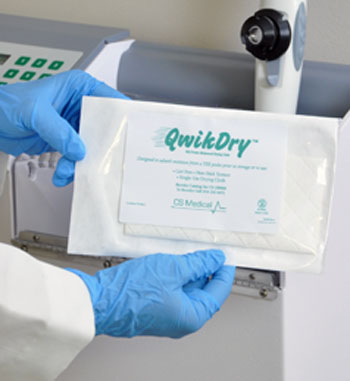New Drying Cloth for Transesophageal Ultrasound Probes
By MedImaging International staff writers
Posted on 12 May 2016
A novel irradiated cloth features a super adsorbent matrix and an ultra-smooth surface for enhanced drying following disinfection and rinse.Posted on 12 May 2016
The CS Medical (Creedmoor, NC, USA) QwikDry transesophageal echo (TEE) ultrasound probe drying cloth is designed to effectively remove moisture from probes at the conclusion of high-level disinfection and rinse with the TD 100 automated TEE probe disinfector, and prior to reuse or storage. Once the disinfected TEE probe is removed from the TD 100, the QwikDry cloth is applied to the insertion shaft to absorb any residual moisture. Each lint-free QwikDry is individually packaged in an easy to open Chevron pouch.

Image: The QwikDry TEE ultrasound probe drying cloth (Photo courtesy of CS Medical).
The cloth was developed since a wet probe, stored in a plastic sheath or hung freely for drying, can allow airborne contaminates to foster growth of spores and bacteria, while other drying methods, such as a reusable sponge, paper towel, cotton cloth, or surgical gauze--though effective in the drying of a TEE probe--could introduce outside contaminates. A sponge, for example could foster spore and bacteria growth while a towel, cloth, or gauze could contain contaminates introduced during the manufacturing or handling process prior to being used.
TEE is an alternative method to perform an echocardiogram, using a specialized probe containing an ultrasound transducer at its tip passed into the patient's esophagus. Unlike standard echocardiography, the transducer is close to the upper chambers of the heart, and thus very clear images of the heart structures and valves can be obtained. TEE is often used in people with a thicker chest wall, in the obese, and to provide information during surgery to repair heart valves, a tear in the aorta, or congenital heart lesions.
Related Links:
CS Medical










 Guided Devices.jpg)



